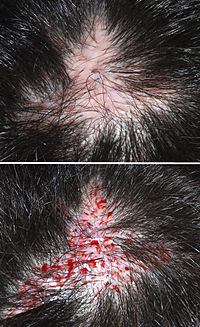
Photo from wikipedia
OBJECTIVE To elucidate the correlation between changes in spinal/pelvic sagittal parameters and clinical treatment outcomes after oblique lumbar interbody fusion (OLIF). METHODS Eighty-two patients with lumbar degenerative disease (LDD) treated… Click to show full abstract
OBJECTIVE To elucidate the correlation between changes in spinal/pelvic sagittal parameters and clinical treatment outcomes after oblique lumbar interbody fusion (OLIF). METHODS Eighty-two patients with lumbar degenerative disease (LDD) treated by OLIF were retrospectively analyzed. The visual analog scale (VAS) score and Oswestry disability index (ODI) were compared before and after surgery. The disc height (DH) and various spinal/pelvic sagittal parameters, including pelvic incidence (PI), pelvic tilt (PT), sacral slope (SS), lumbar lordosis (LL), and sagittal vertical axis (SVA), were measured preoperatively and at the last postoperative follow-up. The correlation between the changes in sagittal parameters before and after surgery and the clinical treatment outcomes were observed. RESULTS The ODI, VAS score, and DH were significantly better at the last follow-up than before surgery. The change in PI was not statistically significant before and after surgery. PT significantly decreased and SS and LL significantly increased after surgery. Significant linear relationships were found for several independent variables (difference in DH before and after surgery, postoperative LL, difference in LL before and after surgery, PI-LL match status, and SVA status) and the dependent variable ODI. The difference in DH before and after surgery showed the strongest correlation. The percentages of PI-LL match were 37% before surgery and 66% after surgery. The percentage of the normal SVA was 9% before surgery and 62% after surgery. CONCLUSIONS OLIF for treatment of LDD had significant clinical outcomes, effectively restored the spinal/pelvic sagittal balance, and helped to improve the patients' clinical conditions.
Journal Title: World neurosurgery
Year Published: 2019
Link to full text (if available)
Share on Social Media: Sign Up to like & get
recommendations!